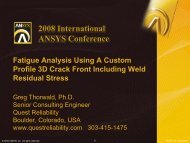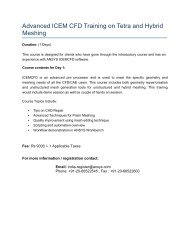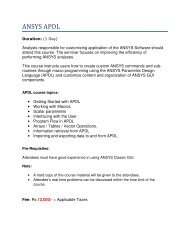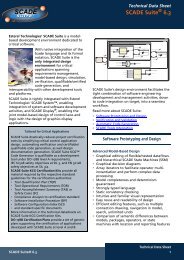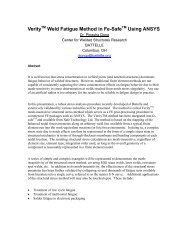Simulation - ANSYS
Simulation - ANSYS
Simulation - ANSYS
Create successful ePaper yourself
Turn your PDF publications into a flip-book with our unique Google optimized e-Paper software.
PRODUCTS & TECHNOLOGY: NONLINEAR<br />
Nonlinear <strong>Simulation</strong><br />
Provides More<br />
Realistic Results<br />
When parts interact and experience large deflections and extreme<br />
conditions, nonlinear technology is required to simulate real-life situations.<br />
By Siddharth Shah, Product Manager, <strong>ANSYS</strong>, Inc.<br />
In today’s competitive environment in which everyone<br />
strives to develop the best design with the best performance,<br />
durability and reliability, it is unrealistic to rely on linear<br />
analysis alone. Analyses must be scaled from single parts<br />
and simplified assembly-level models to complete systemlevel<br />
models that involve multiple complex subassemblies.<br />
As more parts get added to a simulation model, it becomes<br />
more difficult to ignore the nonlinear aspects of the physics,<br />
and, at the same time, expect realistic answers.<br />
In some situations involving single- or multiple-part<br />
models, analysis with linear assumptions can be sufficient.<br />
However, for every assumption made, there is some<br />
sacrifice in the accuracy of the simulation. Ignoring nonlinearities<br />
in a model might lead to overly conservative or weak<br />
design in certain situations, or might result in the omission of<br />
unexpected but valuable information about the design or performance<br />
of the model. It is essential to understand when and<br />
when not to account for nonlinearities. The<br />
following are some situations in which nonlinearities<br />
are commonly encountered.<br />
Contact<br />
Currently, auto-contact detection<br />
in <strong>ANSYS</strong> Workbench <strong>Simulation</strong><br />
allows users to quickly set up contact<br />
(part interactions) between<br />
multiple entity types (solids, sheets,<br />
beams). However, in cases in which<br />
two parts interact with each other, the<br />
parts might stick or slide against<br />
each other instead of remaining<br />
static. Also, their stiffness might<br />
change depending upon whether<br />
they touch each other or not, as<br />
is seen with interference or snapfit<br />
cases. Ignoring sliding may be<br />
acceptable for a large class of problems,<br />
24<br />
<strong>ANSYS</strong> Advantage • Volume II, Issue 2, 2008<br />
Frictional contact between the rotor and the brake<br />
pad in a brake assembly<br />
but for those with moving parts or<br />
that involve friction, it is unwise to<br />
make this assumption.<br />
Geometry<br />
In certain situations, the<br />
deflections of a structure may be<br />
large compared to its physical<br />
dimensions. This usually results<br />
in a variation in the location and<br />
distribution of loads for that structure.<br />
For example, consider a<br />
fishing pole being bent or a large<br />
tower experiencing wind loads.<br />
The loading conditions over the<br />
entire body of the structure will<br />
change as the structure deflects.<br />
Also, in certain slender types<br />
Top-loading simulation<br />
of a plastic bottle<br />
of structures, membrane stresses may cause<br />
the structure to stiffen and, hence, reduce<br />
displacements. One example of this is fuel<br />
tanks used for satellite launchers and<br />
spacecraft. If accurate displacements<br />
are to be computed, geometry nonlinearities<br />
have to be considered.<br />
Material<br />
Material factors become increasingly<br />
important when a structure is<br />
required to function consistently and<br />
reliably in extreme environments —<br />
such as structures that must operate<br />
at high temperatures and pressures,<br />
provide earthquake resistance, or<br />
be impact-worthy or crash-worthy.<br />
Plastics, elastomers and composites<br />
are being used as structural materials<br />
www.ansys.com





